BlackHole
Latest

Researchers may have witnessed the birth of a black hole
Researchers believe they might have an explanation for an incredibly bright event that took place in a distant dwarf galaxy. Scientists observed it last June when the object in question lit up and then faded over the course of 16 days, and it has continued to spark interest and debate. Based on the data collected at the time, a number of researchers now think the event was the creation of either a black hole or a neutron star.
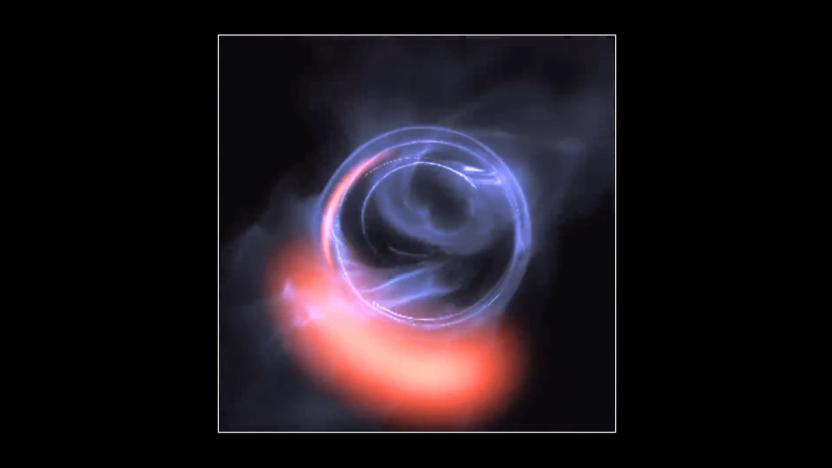
Scientists find evidence of a black hole at our galaxy’s center
Researchers have long suspected that a supermassive black hole lies in the center of our galaxy, and now they have strong evidence to support that suspicion. Using the Very Large Telescope -- an array of four individual telescopes stationed in the Atacama Desert in Chile -- scientists have been observing Sagittarius A* (pronounced Sagittarius A-star), an object in the center of the Milky Way galaxy thought to be a supermassive black hole. During their work, the research team observed three bright flares orbiting around Sagittarius A*, which completed 150-million-mile circuits in just 45 minutes. That's about 30 percent the speed of light.
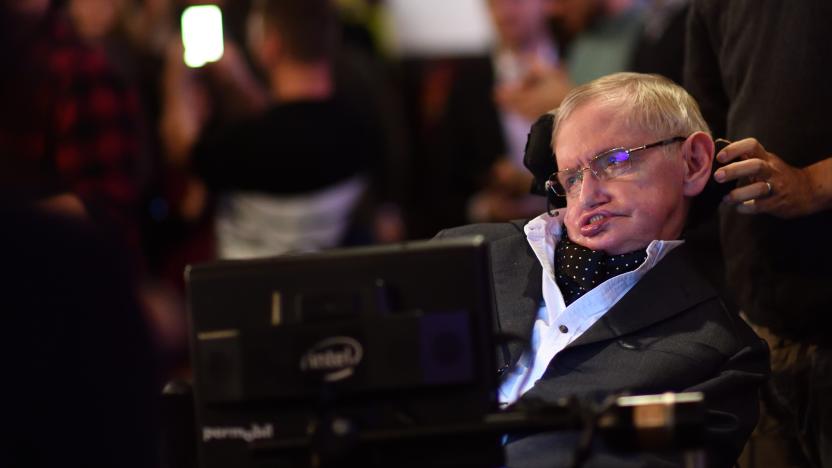
Stephen Hawking's last paper on black holes is now online
Stephen Hawking never stopped trying to unravel the mysteries surrounding black holes -- in fact, he was still working to solve one of them shortly before his death. Now, his last research paper on the subject is finally available online through pre-publication website ArXiV, thanks to his co-authors from Cambridge and Harvard. It's entitled Black Hole Entropy and Soft Hair, and it tackles the black hole paradox. According to Hawking's co-author Malcolm Perry, the paradox "is perhaps the most puzzling problem in fundamental theoretical physics today" and was the center of the late physicist's life for decades.
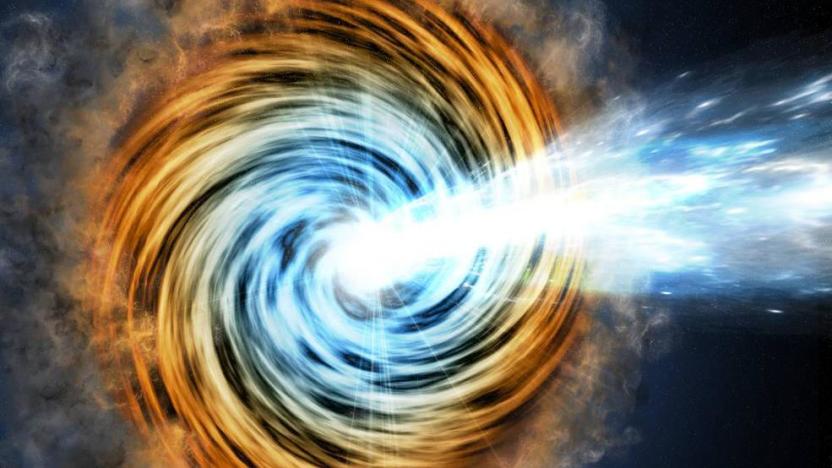
Scientists trace the origin of high-energy cosmic radiation
This week, the National Science Foundation announced a groundbreaking discovery that provides answers to a question scientists have been asking for decades. A team at the NSF IceCube Neutrino Observatory at the Amundsen-Scott South Pole Station was able to trace the source of high-energy cosmic rays to their source: a blazar, which is a galaxy center that produces massive particle jets, powered by a supermassive black hole.

A Stephen Hawking musical tribute was beamed directly at a black hole
The European Space Agency had its own special way of marking a memorial service for astrophysicist Professor Stephen Hawking. At the same time his ashes were interred at Westminster Abbey in London, the ESA beamed music featuring Hawking's famously synthesized voice towards the closest-known black hole.
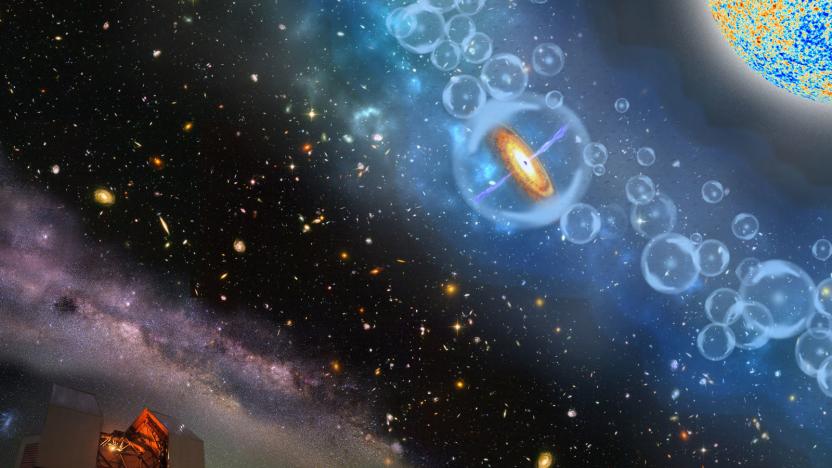
Farthest-ever supermassive black hole reveals the early universe
Quasars are supermassive black holes at the center of galaxies that actively consume gas and dust. As mass falls into the black hole, it forms an accretion disk around the black hole and jets of matter that spew from the black hole. These features make quasars some of the brightest objects in the universe. And now, scientists have discovered the most distant supermassive black hole ever observed, which is within a quasar. Findings will be published in the journal Nature.

Astronomers just measured a whole lot more than gravitational waves
A couple of weeks ago, the LIGO (Laser Interferometer Gravitational-Wave Observatory) and Virgo teams announced the detection of another set of gravitational waves -- the fourth since LIGO's first detection in September of 2015. The observations of these ripples in spacetime are extraordinary in and of themselves, no matter how many times we record them. However, while the first three sets of gravitational waves recorded were by the two LIGO observatories, the fourth was also detected by a newly established third -- Virgo -- located in Italy. And having three detectors allows researchers to triangulate the source of those waves with extraordinary precision.

Scientists record a fourth set of gravitational waves
Last year, researchers confirmed the existence of gravitational waves with two Laser Interferometer Gravitational-wave Observatory (LIGO) detectors. Shortly thereafter, they detected two additional gravitational wave-causing events that sent ripples through the universe. Well, we can now add a fourth to that list, as astronomers announced another set of waves. And for the first time, they observed the waves with a third detector -- the Italy-based Virgo.
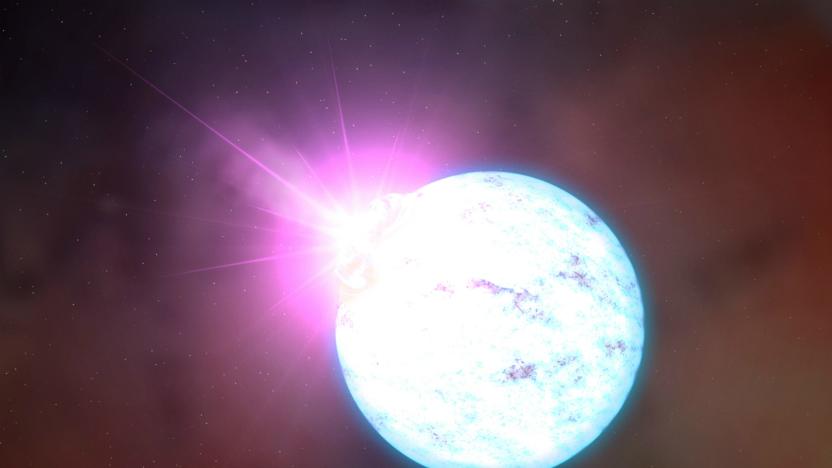
New computer models could direct scientists to epic cosmic events
Now that they're spotting gravitational waves more often, scientists are expanding their search for cosmic events. Specifically, they're using new computer models to depict the cataclysmic collision that occurs when a black hole joins a neutron star (the remnants of an exploded star). The simulations will help detectors track down the actual mergers using telescopes and advanced versions of LIGO (the Laser Interferometer Gravitational-Wave Observatory).
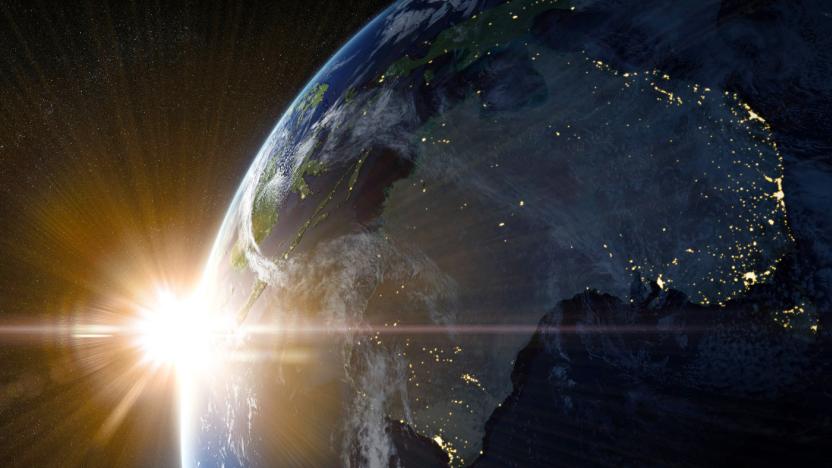
Milky Way's fastest stars could be runaways from another galaxy
The fastest-moving stars in our galaxy, known as hypervelocity stars, may have a more interesting backstory than scientists first thought, according to new research from Cambridge University. Astronomers initially believed these super-rare stars -- only 20 have been identified -- had been expelled from the center of the Milky Way by a supermassive black hole, but the study shows that they may have started their breakneck journeys in another galaxy altogether: the Large Magellanic Cloud (LMC).

Stars can turn into black holes without a supernova
As a rule, astronomers believe that stars have to explode in a supernova before they collapse into black holes. That violent death is always the cue, right? Not necessarily. Researchers have spotted a massive star 22 million light years away, N6946-BH1, that appears to have skipped the supernova step entirely -- it brightened slightly and just disappeared. Checks have ruled out a dimmed star or dust. And this probably isn't a one-off incident, either. Ohio State University's Christopher Kochanek tells NASA that 10 to 30 percent of massive stars might die in failed supernovae.

Remembering the first 'photo' of a black hole
Black holes are so outlandish that the scientists who first thought them up figured they couldn't possibly exist in reality. They form from massive, collapsed stars and are so dense that nothing can escape their gravitational pull, including light. Black holes mess with spacetime so badly that scientists have long wondered: How do these things look, exactly? We may be on the cusp of seeing one thanks to the Event Horizon Telescope, but back in 1979, Jean-Pierre Luminet created the first "image" using nothing but an early computer, lots of math and India ink.
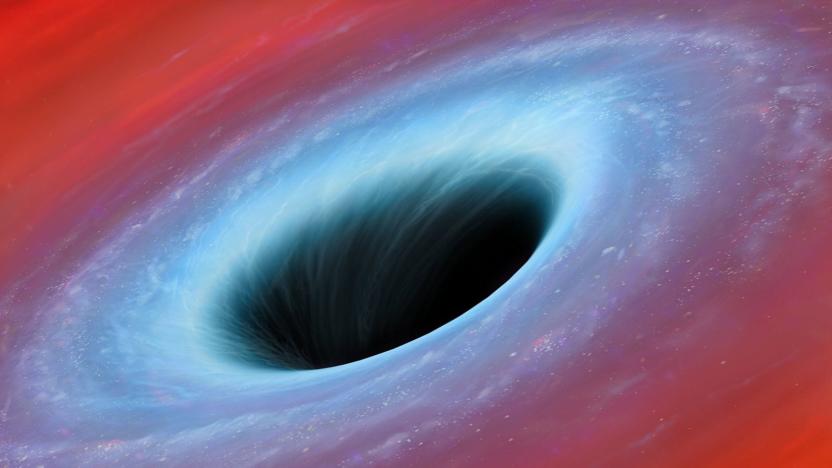
Astronomers may have taken the first photo of a black hole
The Event Horizon Telescope project's astronomers can now breathe a sigh of relief. They finally managed to observe Sagittarius A* for five sleepless nights after switching on the array on April 4th. In other words, the team might have taken the first picture of a black hole ever. There were nights when they had to stop their observations due to bad weather or something going wrong with their system, but they ultimately wrapped up on April 11th, 11:22 AM ET.

Hubble telescope spots 'runaway' black hole
Astronomers using NASA's Hubble Space Telescope have observed a supermassive black hole with a mass one million times that of our Sun hurtling away from its parent galaxy. It's the first confirmed case out of several suspected "runaway black holes," which required an immense amount of energy to get launched from the center of its galaxy. How much?

Supermassive black hole set a record for longest lunch ever
When a black hole eats a nearby star, the resulting X-rays typically fade within a year or so. That's why astronomers are excited about a giant black hole that's been shedding telltale radiation for close to 10 years.

Gamma ray telescope spots ancient, intense black holes
NASA's Fermi gamma ray telescope has been working overtime, it seems. Scientists using the instrument have spotted extreme astronomical phenomenon both at the far edge of the universe and close to home. They've detected the farthest known blazars, or galaxies whose central black holes are so massive (over 1 million times the Sun's mass) that they emit extremely intense light in every spectrum, including gamma rays. The oldest example existed just 1.4 billion years after the Big Bang -- ancient compared to the previous record-setter, which was visible "just" 2.1 billion years after the birth of the universe.
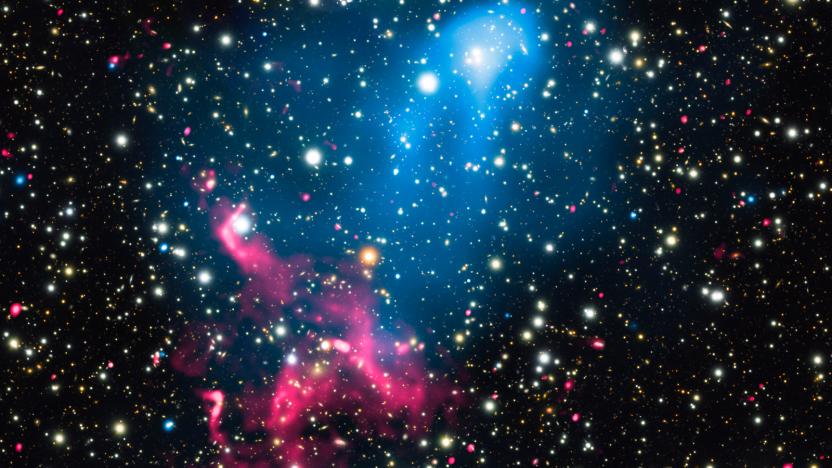
Scientists discover a cosmic-scale particle accelerator
Suddenly, even the Large Hadron Collider seems downright quaint. Researchers have found a combination of cosmic phenomena that's creating the universe's largest known particle accelerator. At least one supermassive black hole in a galaxy cluster has created a electromagnetic tunnel that's accelerating gas to high speeds, only for the gas to travel even faster as it interacts with shock waves from another cluster colliding with the first. The result is particles traveling at a significant portion of the speed of light -- no mean feat for anything that isn't, well, light.
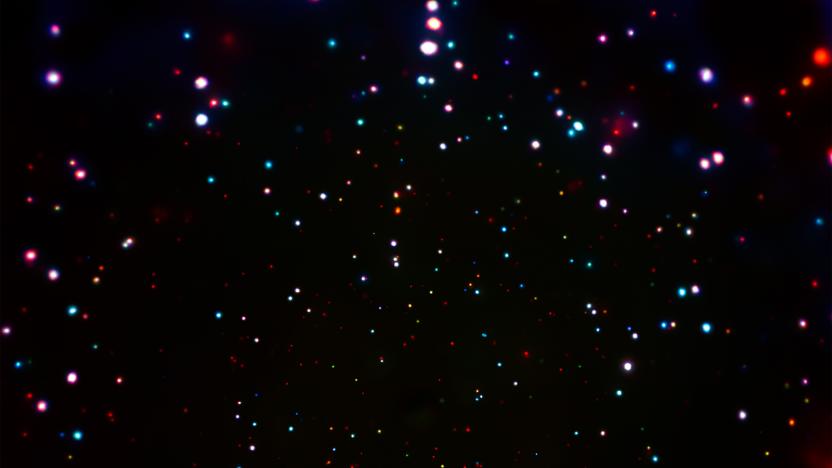
Deepest X-ray image to date uncovers a black hole bonanza
Believe it or not, that's not a star field you're looking at. Researchers have used NASA's Chandra X-ray Observatory to produce an X-ray image of space (the deepest-ever X-ray, in fact) that has uncovered an abundance of supermassive black holes -- they represent 70 percent of the objects in the picture above. Many of these holes would normally be undetectable, especially distant ones from the early universe, and it took 11.5 weeks of total observation time to spot them all. Think of it as a very, very long exposure photo, just for X-ray emissions.
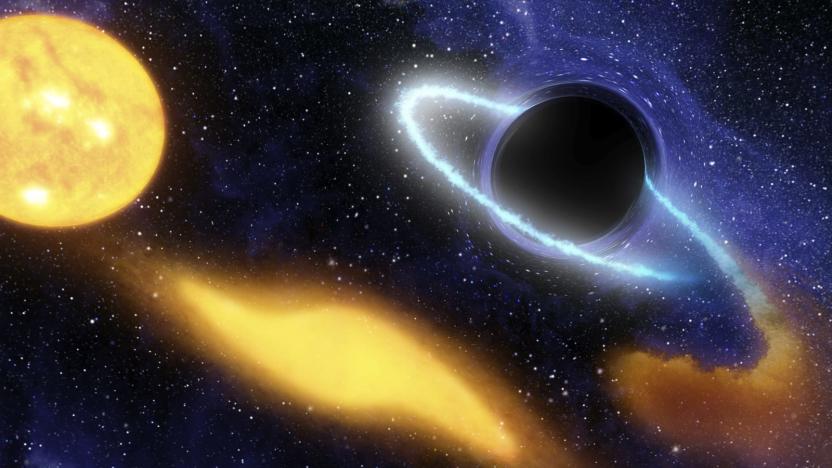
Black hole detection is becoming much easier
It's still relatively difficult to spot black holes (after all, they trap light), but it may be relatively commonplace in the near future. An international team of researchers has developed a detection technique that should identify a more frequent 10 black holes per year. By using radio telescopes to capture multiple snapshots of gravitational microlensing events (where objects like black holes bend light), you can obtain details like distance, mass and velocity for subjects you can't easily study using visible light.

Giant black hole could be to blame for brightest supernova ever
3.8 billion years ago, a star in the southern sky exploded and released 570 billion times more light than our sun and more than twice as much as any other recorded supernova. That star, dubbed ASASSN-15lh, is the brightest supernovae ever observed and, a year after witnessing its superluminescence in 2015, astronomers believe that they've figured out why it burned so brightly: It was being eaten by a supermassive black hole a billion times more massive than the sun.










